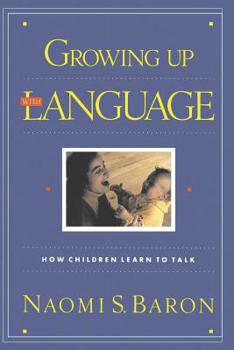Growing Up with Language
Select Format
Select Condition 
Book Overview
"It is a gift when an academic can take a difficult subject and make it not just accessible but actually enjoyable for the average reader. Anyone who is around young children will find useful information on how humans create speech and language."--The Bloomsbury Review Children learn to make sense of the babble around them and become coherent speakers and incipient readers in just five or six years. In this remarkable book, linguist Naomi Baron takes us on a journey through language, showing the variety of ways in which children crack the language code and master the means of expression, and how parents play a vital role in the process. Every parent will see something of his or her child in the numerous and vivid examples; those whose kids don't fit preconceived norms will find reassurance and guidance in these pages. Spiced with enchanting examples of children putting their first words together, struggling to understand meaning, and coming to use language as a creative tool, Growing Up with Language reminds us that underneath all their efforts is the drive to make sense of the world.
Format:Paperback
Language:English
ISBN:020162480X
ISBN13:9780201624809
Release Date:October 1993
Publisher:Balance
Length:286 Pages
Weight:0.90 lbs.
Dimensions:0.8" x 6.1" x 9.2"
Customer Reviews
1 rating
Language acquisition at a glance
Published by Thriftbooks.com User , 26 years ago
Growing Up With Language is Naomi Baron's fifth book about language. Baron writes this book for "parents, medical practitioners, educators and students." Since her graduate work, Baron has tried to reconcile the gap between studying in academia and practice and research with real children. Three questions remained unanswered. The first "How do you teach language?" The third and most difficult , "How do children crack the language code?" Any new parent or parent to be who has read Infants and Mothers by T. Berry Brazelton, will feel comfortable with the format of this book. Brazelton describes the development of three babies that he calls "Quiet," "Active," and "Average." Baron also chooses three styles of language learners that she identifies as, Sara, Ryan, and Alex. Throughout the book Baron includes a myriad of anecdotes to illustrate each language learning milestone for each of her three learners. When reading the book from cover to cover, you will discover that information is often repeated. Some readers will read specific chapters dealing with grammar, or baby talk, and will find the repetition of information helpful. Others will find it redundant. Each chapter concludes with an "Ideas and Alerts" section. These sections and the concluding Notes section are invaluable. Baron also chooses three "normal" children. In Chapter One, Baron introduces her three subjects and gives an outline for the remaining chapters. Baron identifies seven phases of language development and four themes. The first theme involves the "Conversational Imperative." The imperative compels people to talk to babies, pets, and stuffed animals. Theme II is the "Phantom Normal." All parents are yearning to know that their child is "normal." Theme III is "Language Orienteering," this is Baron's term for how children learn language. "Language Saturation," is how language learning is measured. Language is a social activity. Parents and children engage in a "duet" of conversation. Chapter Two illustrates the conversational relationships of the three children and their families. Baron discusses the common features of babytalk and the development of language from birth to the emergence words. Biology impacts language development. Changes take place with the palate, tongue and larynx that allow an infant to first use his mouth for nourishment and later for communication. Short hand allowed secretaries to conserve time and space without losing content. Children create their own spoken shorthand when communicating with others. Young children exploit their expressive vocabulary confident that they have maintained meaning, even when adults need an interpreter. Chapter Three, "Language on a Shoestring," illustrates through a variety of anecdotes how children attempt to communicate using their limited language resources. Adult






